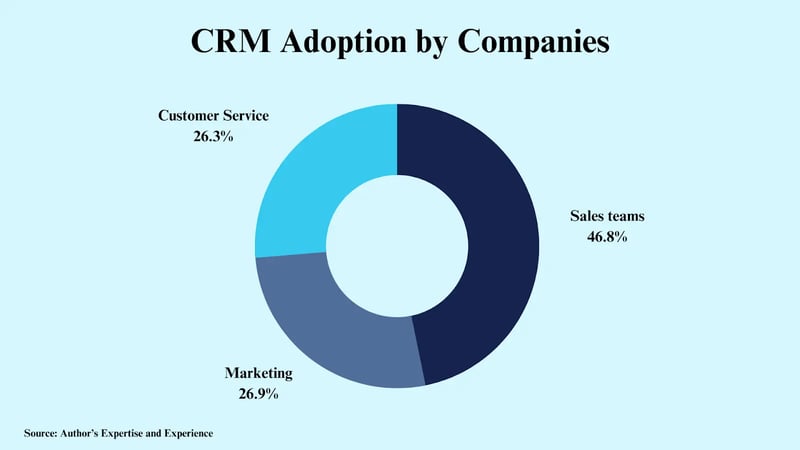E. Improved Customer Service
CRM improves customer service by arming agents with complete information:
-
Agents have access to full customer histories in one place for better context.
-
Response times can be faster with all data already in the CRM system—no waiting for other teams.
-
Issues can be routed more seamlessly to the correct team with workflow tools.
-
Knowledge bases provide agents with answers to common questions quickly.
-
Complete customer data leads to higher satisfaction during service interactions.
In summary, CRM software connects sales and marketing teams by sharing data. This creates tight alignment that was impossible with siloed teams and information. CRM integration is essential for sales and marketing efficiency in modern businesses.
The Transformative Impact of CRM Integration
Let’s explore the data-backed transformations CRM integration drives in sales and marketing processes.
A. Improved Lead Management
CRM helps manage leads better between marketing and sales. The lead transfer is smoother with CRM. Marketing can easily hand leads over to sales teams within the CRM platform. Lead nurturing also improves. Marketing and sales can work together on strategies to qualify and nurture leads. CRM data helps prioritize which sales-ready leads to focus on first.
According to a poll, 47% of businesses will increase spending on customer service CRM. This is to boost lead management through better collaboration between teams.
B. Data-Driven Decision Making
CRM software combines customer data from sales, marketing, and service teams. It integrates this data with marketing analytics capabilities. This gives a data-driven view of:
-
Which marketing campaigns are performing well and which are not?
-
The conversion rates of leads through the sales funnel.
-
Patterns in the sales cycle and seasonality.
Having these CRM analytics empowers data-driven decisions:
-
Marketing can optimize underperforming campaigns by adjusting targeting or messaging based on insights.
-
Sales can give more precise predictions of future revenue and pipeline health.
-
Managers can split up resources like budget money between sales and marketing. They can base this on which initiatives give the best returns.
The market confirms the value of data-driven CRM. Revenues for CRM software are expected to surpass $80 billion globally by 2025. Companies are leveraging integrated CRM data and analytics for smarter decision-making.
Overcoming Challenges in CRM Integration
Integrating CRM across sales and marketing has big benefits. But it also comes with challenges. Here are some ways to overcome common hurdles:
-
Get executive buy-in first. Top-down support is crucial for adoption. Show leadership how CRM drives growth through collaboration. Address concerns with transparent solutions.
-
Involve teams in the rollout. Sales and marketing should give input on workflows. This increases acceptance and comfort with the new tools.
-
Clean customer data before migrating to CRM. Garbage in, garbage out. CRM analytics suffer if data is messy.
-
Phase the rollout by team or region. Gradually, onboarding to CRM is less disruptive. It allows testing and learning before company-wide adoption.
-
Train thoroughly on CRM capabilities. Many fail to leverage CRM fully due to a lack of learning. Ongoing education reduces friction.
-
Integrate incentives with CRM goals. Compensate for behaviors that support cross-team collaboration in the platform.
-
With proper change management, companies can overcome hurdles. CRM integration may encounter roadblocks but delivers immense value.
Future Trends and Evolutions
As CRM integration evolves, new trends are emerging:
-
AI CRMs: CRM platforms are now using AI to make intelligent predictions and suggestions. For example, Salesforce Einstein or HubSpot AI.
-
Hybrid/multi-cloud: Companies are using a mix of public cloud, private cloud, and on-site models together for CRM.
-
Industry CRMs: There are now CRM platforms made just for specific industries.
These trends show CRM integration is becoming smarter and more customized.
The rising SaaS CRM market confirms this direction. SaaS CRM spending is expected to reach $42 billion by 2026. It will occupy 75% of total CRM software spending.
Companies want CRM systems designed for their industry and with smart AI features. They also want the CRM to work with their plans for using cloud computing services. CRM integration is becoming more advanced to serve these needs.
Conclusion
In summary, integrating CRM creates tight collaboration between sales and marketing teams. It unifies customer data for a single view. It streamlines workflows to connect teams. And it provides shared goals and metrics. With CRM, sales and marketing can work seamlessly together.
This drives business growth through enhanced revenue, better leads, and improved customer experiences. Aligning sales and marketing with CRM should be a priority for companies seeking growth.
CRM Frequently Asked Questions







